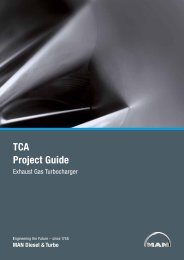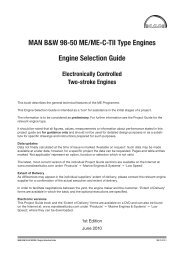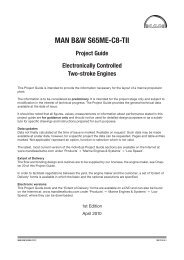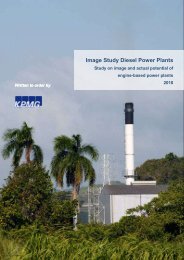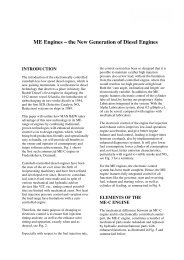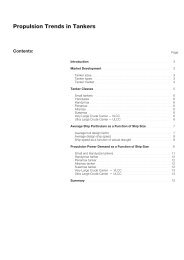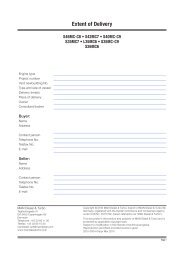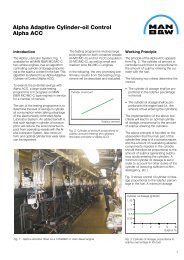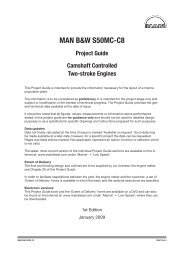This section is available on request - MAN Diesel & Turbo
This section is available on request - MAN Diesel & Turbo
This section is available on request - MAN Diesel & Turbo
You also want an ePaper? Increase the reach of your titles
YUMPU automatically turns print PDFs into web optimized ePapers that Google loves.
<strong>MAN</strong> B&W <strong>Diesel</strong> A/S 6.04<br />
The derated cooler capacities may then be found<br />
by means of following equati<strong>on</strong>s:<br />
Q = Q air, M air, L1 x (Q / 100)<br />
air%<br />
Q = Q jw, M jw, L1 x (Q / 100)<br />
jw%<br />
Q = Q lub, M lub, L1 x (Q / 100)<br />
lub%<br />
and for a central cooling water system the central<br />
cooler heat d<str<strong>on</strong>g>is</str<strong>on</strong>g>sipati<strong>on</strong> <str<strong>on</strong>g>is</str<strong>on</strong>g>:<br />
Q = Q + Q + Q cent,M air,M jw,M lub,M<br />
Pump capacities<br />
The pump capacities given in the ‘L<str<strong>on</strong>g>is</str<strong>on</strong>g>t of Capacities’<br />
refer to engines rated at nominal MCR (L 1 ). For<br />
lower rated engines, <strong>on</strong>ly a marginal saving in the<br />
pump capacities <str<strong>on</strong>g>is</str<strong>on</strong>g> obtainable.<br />
To ensure proper lubricati<strong>on</strong>, the lubricating oil pump<br />
must remain unchanged.<br />
Also, the fuel oil circulating and supply pumps should<br />
remain unchanged.<br />
In order to ensure reliable starting, the starting air<br />
compressors and the starting air receivers must also<br />
remain unchanged.<br />
The jacket cooling water pump capacity <str<strong>on</strong>g>is</str<strong>on</strong>g> relatively<br />
low. Practically no saving <str<strong>on</strong>g>is</str<strong>on</strong>g> possible, and it <str<strong>on</strong>g>is</str<strong>on</strong>g> therefore<br />
unchanged.<br />
Seawater cooling system<br />
The derated seawater pump capacity <str<strong>on</strong>g>is</str<strong>on</strong>g> equal to<br />
the sum of the below found derated seawater flow<br />
capacities through the scavenge air and lube oil<br />
coolers, as these are c<strong>on</strong>nected in parallel.<br />
The seawater flow capacity for each of the scavenge<br />
air, lube oil and jacket water coolers can be<br />
reduced proporti<strong>on</strong>ally to the reduced heat d<str<strong>on</strong>g>is</str<strong>on</strong>g>sipati<strong>on</strong>s<br />
found in Figs. 6.04.01, 6.04.02 and 6.04.03,<br />
respectively i.e. as follows:<br />
V = V sw,air,M sw,air,L1 x (Q / 100)<br />
air%<br />
V = V sw,lub,M sw,lub.L1 x Q / 100)<br />
lub%<br />
V = V sw,jw,M sw,lub,M<br />
However, regarding the scavenge air cooler(s), the<br />
engine maker has to approve th<str<strong>on</strong>g>is</str<strong>on</strong>g> reducti<strong>on</strong> in order<br />
Page 2 of 12<br />
to avoid too low a water velocity in the scavenge air<br />
cooler pipes.<br />
As the jacket water cooler <str<strong>on</strong>g>is</str<strong>on</strong>g> c<strong>on</strong>nected in series<br />
with the lube oil cooler, the seawater flow capacity<br />
for the latter <str<strong>on</strong>g>is</str<strong>on</strong>g> used also for the jacket water cooler.<br />
Central cooling water system<br />
If a central cooler <str<strong>on</strong>g>is</str<strong>on</strong>g> used, the above still applies,<br />
but the central cooling water capacities are used<br />
instead of the above seawater capacities. The seawater<br />
flow capacity for the central cooler can be<br />
reduced in proporti<strong>on</strong> to the reducti<strong>on</strong> of the total<br />
cooler heat d<str<strong>on</strong>g>is</str<strong>on</strong>g>sipati<strong>on</strong>, i.e. as follows:<br />
V =V cw,air,M<br />
cw,air,L1 x (Q / 100)<br />
air%<br />
=Vcw,lub,L1 x (Q / 100)<br />
lub%<br />
Vcw,lub,M Vcw,jw,M =V cw,lub,M<br />
Vcw,cent,M =V + V cw,air,M cw,lub,M<br />
Vsw,cent,M =Vsw,cent,L1 x Qcent,M / Qcent,L1 Pump pressures<br />
Irrespective of the capacities selected as per the<br />
above guidelines, the below-menti<strong>on</strong>ed pump heads<br />
at the menti<strong>on</strong>ed maximum working temperatures<br />
for each system shall be kept:<br />
Fuel oil supply pump 4 100<br />
Fuel oil circulating pump 6 150<br />
Lubricating oil pump 4.3 70<br />
Seawater pump 2.5 50<br />
Central cooling water pump 2.5 80<br />
Jacket water pump 3.0 100<br />
Flow velocities<br />
Pump<br />
head bar<br />
Max. working<br />
temp. °C<br />
For external pipe c<strong>on</strong>necti<strong>on</strong>s, we prescribe the following<br />
maximum velocities:<br />
Marine diesel oil ......................................... 1.0 m/s<br />
Heavy fuel oil.............................................. 0.6 m/s<br />
Lubricating oil............................................. 1.8 m/s<br />
Cooling water ............................................. 3.0 m/s<br />
L70ME-C, S60ME-C 198 43 85-0.1



